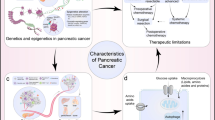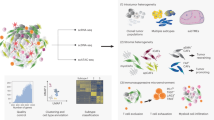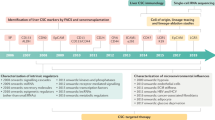Abstract
As our understanding of pancreatic cancer evolves, evidence is growing to support a role for cancer stem cells in this devastating disease. Cancer stem cells constitute a distinct subpopulation in the tumor and are considered to drive both tumorigenesis and metastasis; these cells are thought to be highly resistant to standard treatment modalities. Here we review the current knowledge on pancreatic cancer stem cells and the implementation of cancer stem cell markers as prognostic or predictive biomarkers. We also discuss prospects for the use of cancer stem cells as targets for future therapeutic regimens in pancreatic cancer.
Key Points
-
Conventional chemotherapy and radiotherapy affect rapidly dividing pancreatic cancer cells but fail to target cancer stem cells that drive tumorigenesis and metastasis
-
Pancreatic cancer stem cells with either a CD44+CD24+ESA+ or a CD133+ phenotype have been identified from primary human pancreatic ductal adenocarcinoma
-
The metastatic potential of pancreatic ductal adenocarcinoma seems to be determined by a subpopulation of CD133+ cells that co-express CXCR4
-
Developmental signaling pathways that regulate self-renewal and cell fate in normal stem cells are also involved in pancreatic cancer stem cells and might serve as novel biomarkers and therapeutic targets
-
Any treatment designed to eradicate pancreatic cancer needs to eliminate all cancer stem cells from the tumor
-
The success of any approach that targets pancreatic cancer stem cells will depend upon further identification and characterization of normal pancreatic stem cells, cancer stem cells and the surrounding tumor stroma
This is a preview of subscription content, access via your institution
Access options
Subscribe to this journal
Receive 12 print issues and online access
$209.00 per year
only $17.42 per issue
Buy this article
- Purchase on Springer Link
- Instant access to full article PDF
Prices may be subject to local taxes which are calculated during checkout


Similar content being viewed by others
References
Hill, R. P. & Perris, R. “Destemming” cancer stem cells. J. Natl Cancer Inst. 99, 1435–1440 (2007).
Fishman, M. P. & Melton, D. A. Pancreatic lineage analysis using a retroviral vector in embryonic mice demonstrates a common progenitor for endocrine and exocrine cells. Int. J. Dev. Biol. 46, 201–207 (2002).
Xu, X. et al. β Cells can be generated from endogenous progenitors in injured adult mouse pancreas. Cell 132, 197–207 (2008).
Dor, Y., Brown, J., Martinez, O. I. & Melton, D. A. Adult pancreatic β-cells are formed by self-duplication rather than stem-cell differentiation. Nature 429, 41–46 (2004).
Bonner-Weir, S. & Sharma, A. Pancreatic stem cells. J. Pathol. 197, 519–526 (2002).
Zhou, Q. et al. A multipotent progenitor domain guides pancreatic organogenesis. Dev. Cell 13, 103–114 (2007).
Bonnet, D. & Dick, J. E. Human acute myeloid leukemia is organized as a hierarchy that originates from a primitive haematopoietic cell. Nat. Med. 3, 730–737 (1997).
Al-Hajj, M., Wicha, M. S., Benito-Hernandez, A., Morrison, S. J. & Clarke, M. F. Prospective identification of tumorigenic breast cancer cells. Proc. Natl Acad. Sci. USA 100, 3983–3988 (2003).
Fidler, I. J. Metastasis: quantitative analysis of distribution and fate of tumor embolized and labeled with 125I-5-iodo-2′-deoxyuridine. J. Natl Cancer Inst. 45, 773–782 (1970).
Clarke, M. F. & Fuller, M. Stem cells and cancer: two faces of Eve. Cell 124, 1111–1115 (2006).
Reya, T., Morrison, S. J., Clarke, M. F. & Weissman, I. L. Stem cells, cancer, and cancer stem cells. Nature 414, 105–111 (2001).
Clarke, M. F. et al. Cancer stem cells-—perspectives on current status and future directions: AACR Workshop on Cancer Stem Cells. Cancer Res. 66, 9339–9344 (2006).
Li, L. & Neaves, W. B. Normal stem cells and cancer stem cells: the niche matters. Cancer Res. 66, 4553–4557 (2006).
Yoo, M. H. & Hatfield, D. L. The cancer stem cell theory: is it correct? Mol. Cells 26, 514–516 (2008).
Kelly, P. N., Dakic, A., Adams, J. M., Nutt, S. L & Strasser, A. Tumour growth need not be driven by rare cancer stem cells. Science 317, 337 (2007).
Vermeulen, L., Sprick, M. R., Kemper, K., Stassi, G. & Medema, J. P. Cancer stem cells—old concepts, new insights. Cell Death Differ. 15, 947–958 (2008).
Challen, G. A. & Little, M. H. A side order of stem cells: the SP phenotype. Stem Cells 24, 3–12 (2006).
Chen, J. et al. Pituitary progenitor cells tracked down by side population dissection. Stem Cells 27, 1182–1195 (2009).
Haraguchi, N. et al. Cancer stem cells in human gastrointestinal cancers. Hum. Cell 19, 24–29 (2006).
Wu, C. & Alman, B. A. Side population cells in human cancers. Cancer Lett. 268, 1–9 (2008).
Ibrahim, S. F., Diercks, A. H., Petersen, T. W. & van den Engh, G. Kinetic analyses as a critical parameter in defining the side population (SP) phenotype. Exp. Cell Res. 313, 1921–1926 (2007).
Montanaro, F. et al. Demystifying SP cell purification: viability, yield and phenotype are defined by isolation parameters. Exp. Cell Res. 298, 144–154 (2004).
Olempska, M. et al. Detection of tumour stem cell markers in pancreatic carcinoma cell lines. Hepatobiliary Pancreat. Dis. Int. 6, 92–97 (2007).
Haraguchi, N. et al. Characterization of a side population of cancer cells from human gastrointestinal system. Stem Cells 24, 506–513 (2006).
Zhou, J. et al. Persistence of side population cells with high drug efflux capacity in pancreatic cancer. World J. Gastroenterol. 14, 925–930 (2008).
Gou, S. et al. Establishment of clonal colony-forming assay for propagation of pancreatic cancer cells with stem cell properties. Pancreas 34, 429–435 (2007).
Shah, A. N. et al. Development and characterization of gemcitabine-resistant pancreatic tumour cells. Ann. Surg. Oncol. 14, 3629–3637 (2007).
Hermann, P. C. et al. Distinct populations of cancer stem cells determine tumour growth and metastatic activity in human pancreatic cancer. Cell Stem Cell 1, 313–323 (2007).
Burkert, J., Otto, W. R. & Wright, N. A. Side populations of gastrointestinal cancers are not enriched in stem cells. J. Pathol. 214, 564–573 (2008).
Li, C. et al. Identification of pancreatic cancer stem cells. Cancer Res. 67, 1030–1037 (2007).
Müller, A. et al. Involvement of chemokine receptors in breast cancer metastasis. Nature 410, 50–56 (2001).
Croker, A. K. & Allan, A. l. Cancer stem cells: implications for the progression and treatment of metastatic disease. J. Cell Mol. Med. 12, 374–390 (2008).
Gremeaux, L. et al. In search of cancer stem cells in primary human tumors: a “side population” is present in both benign and malignant neoplasms. Presented at the ISSCR 6th Annual Meeting.
Boman, B. M. & Wicha, M. S. Cancer stem cells: a step toward the cure. J. Clin. Oncol. 26, 2795–2799 (2008).
Gu, G., Dubauskaite, J. & Melton, D. A. Direct evidence for the pancreatic lineage: NGN3+ cells are islet progenitors and are distinct from duct progenitors. Development 129, 2447–2457 (2002).
Liu, T. et al. Pancreas duodenal homeobox-1 expression and significance in pancreatic cancer. World J. Gastroenterol. 13, 2615–2618 (2007).
Quint, K. et al. The expression pattern of PDX-1, SHH, Patched and Gli-1 Is associated with pathological and clinical features in human pancreatic cancer. Pancreatology 9, 116–126 (2008).
Koizumi, M. et al. Increased PDX-1 expression is associated with outcome in patients with pancreatic cancer. Surgery 134, 260–266 (2003).
Bolos, V., Grego-Bessa, J. & de la Pompa, J. L. Notch signalling in development and cancer. Endocr. Rev. 28, 339–363 (2007).
Miyamoto, Y. et al. Notch mediates TGFα-induced changes in epithelial differentiation during pancreatic tumorigenesis. Cancer Cell 3, 565–576 (2003).
van Es, J. H. et al. Notch–γ-secretase inhibition turns proliferative cells in intestinal crypts and adenomas into goblet cells. Nature 435, 959–963 (2005).
Zaret, K. S. & Grompe, M. Generation and regeneration of cells of the liver and pancreas. Science 322, 1490–1494 (2008).
Thayer, S. P. et al. Hedgehog is an early and late mediator of pancreatic cancer tumourigenesis. Nature 425, 851–856 (2003).
Liu, M. S., Yang, P. Y & Yeh, T. S. Sonic hedgehog signalling pathway in pancreatic cystic neoplasms and ductal adenocarcinoma. Pancreas 34, 340–346 (2007).
James, L. F., Panter, K. E., Gaffield, W. & Molyneux, R. J. Biomedical applications of poisonous plant research. J. Agric. Food Chem. 52, 3211–3230 (2004).
Berman, D. M. et al. Widespread requirement for Hedgehog ligand stimulation in growth of digestive tract tumours. Nature 425, 846–851 (2003).
Feldmann, G. et al. Blockade of hedgehog signalling inhibits pancreatic cancer invasion and metastases: a new paradigm for combination therapy in solid cancers. Cancer Res. 67, 2187–2196 (2007).
Yoshida, K. et al. Screening of genes specifically activated in the pancreatic juice ductal cells from the patients with pancreatic ductal carcinoma. Cancer Sci. 94, 263–270 (2003).
Immervoll, H., Hoem, D., Sakariassen, P. Ø., Steffensen, O. J & Molven, A. Expression of the “stem cell marker” CD133 in pancreas and pancreatic ductal adenocarcinomas. BMC Cancer 8, 48 (2008).
Maeda, S. et al. CD133 expression is correlated with lymph node metastasis and vascular endothelial growth factor-C expression in pancreatic cancer. Br. J. Cancer 98, 1389–1397 (2008).
Kayali, A. G. et al. The stromal cell-derived factor-1α–CXCR4 ligand-receptor axis is critical for progenitor survival and migration in the pancreas. J. Cell Biol. 163, 859–869 (2003).
Taichman, R. S. et al. Use of the stromal cell-derived factor-1–CXCR4 pathway in prostate cancer metastasis to bone. Cancer Res. 62, 1832–1837 (2002).
Kucia, M. et al. CXCR4-SDF-1 signalling, locomotion, chemotaxis and adhesion. J. Mol. Histol. 35, 233–245 (2004).
Garcea, G., Neal, C. P., Pattenden, C. J., Steward, W. P. & Berry, D. P. Molecular prognostic markers in pancreatic cancer: a systematic review. Eur. J. Cancer 41, 2213–2236 (2005).
Gotoda, T. et al. Expression of CD44 variants and its association with survival in pancreatic cancer. Jpn J. Cancer Res. 89, 1033–1040 (1998).
Charrad, R. S. et al. Effects of anti-CD44 monoclonal antibodies on differentiation and apoptosis of human myeloid leukemia cell lines. Blood 99, 290–299 (2002).
Fong, D. et al. Ep-CAM expression in pancreatic and ampullary carcinomas: frequency and prognostic relevance. J. Clin. Pathol. 61, 31–35 (2008).
He, X. C. et al. PTEN-deficient intestinal stem cells initiate intestinal polyposis. Nat. Genet. 39, 189–198 (2007).
Di Cristofano, A. & Pandolfi P. P. The multiple roles of PTEN in tumour suppression. Cell 100, 387–390 (2000).
Yilmaz, O. H. et al. Pten dependence distinguishes haematopoietic stem cells from leukaemia-initiating cells. Nature 441, 475–482 (2006).
Okada, T., Sawada, T. & Kubota, K. Rapamycin enhances the anti-tumour effect of gemcitabine in pancreatic cancer cells. Hepatogastroenterology 54, 2129–2133 (2007).
Cheng, J. Q., Lindsley, C. W., Cheng, G. Z., Yang, H. & Nicosia, S. V. The Akt–PKB pathway: molecular target for cancer drug discovery. Oncogene 24, 7482–7492 (2005).
Rhodes, N. et al. Characterization of an Akt kinase inhibitor with potent pharmacodynamic and antitumour activity. Cancer Res. 68, 2366–2374 (2008).
Dingli, D. & Michor, F. Successful therapy must eradicate cancer stem cells. Stem Cells 24, 2603–2610 (2006).
Gil, J., Stembalska, A., Pesz, K. A. & Sasiadek, M. M. Cancer stem cells: the theory and perspectives in cancer therapy. J. Appl. Genet. 49, 193–199 (2008).
Wicha, M. S. Cancer stem cell heterogeneity in hereditary breast cancer. Breast Cancer Res. 10, 105 (2008).
Acknowledgements
The authors gratefully thank Vik Van Duppen from the Laboratory of Experimental Hematology (SCIL) for sharing his knowledge on fluorescence-activated cell sorting, and Herlinda Vekemans from the ILT (K. U. Leuven) for medical English proofreading of this manuscript.
Author information
Authors and Affiliations
Corresponding author
Ethics declarations
Competing interests
The authors declare no competing financial interests.
Rights and permissions
About this article
Cite this article
Sergeant, G., Vankelecom, H., Gremeaux, L. et al. Role of cancer stem cells in pancreatic ductal adenocarcinoma. Nat Rev Clin Oncol 6, 580–586 (2009). https://doi.org/10.1038/nrclinonc.2009.127
Published:
Issue Date:
DOI: https://doi.org/10.1038/nrclinonc.2009.127
This article is cited by
-
Role of the long non-coding RNAs in regulation of Gemcitabine response in tumor cells
Cancer Cell International (2023)
-
Targeting cancer stem cells with polymer nanoparticles for gastrointestinal cancer treatment
Stem Cell Research & Therapy (2022)
-
Targeting hypoxic tumor microenvironment in pancreatic cancer
Journal of Hematology & Oncology (2021)
-
Combined use of CEMIP and CA 19-9 enhances diagnostic accuracy for pancreatic cancer
Scientific Reports (2018)
-
FOXO3 is essential for CD44 expression in pancreatic cancer cells
Oncogene (2017)



